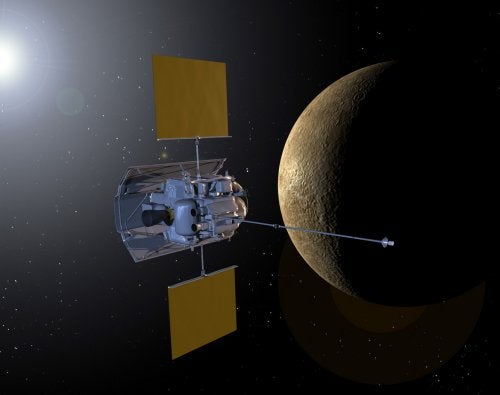The MESSENGER spacecraft blasted off from NASA’s Kennedy Space Center at Cape Canaveral, Florida, at 2:15:56 A.M. Eastern Daylight Time, August 3, 2004. This was one day late, thanks to Tropical Storm (now Hurricane) Alex. MESSENGER is the first mission to Mercury since Mariner 10 in the mid-1970s.
While Mercury is the swiftest-orbiting planet, taking just 88 Earth days to circle the Sun, MESSENGER’s long flight path unrolls at a very leisurely pace. One year after launch, the spacecraft returns to Earth and flies past (August 2005), then come two flybys of Venus (October 2006 and June 2007), followed by three of Mercury (January and October 2008 and September 2009).
These encounters provide opportunities for instrument calibrations and some scientific investigations. More crucially, however, the multiple-planet encounters slow the spacecraft as it falls sunward, pulled by our star’s powerful gravity. The encounters ensure that the spacecraft needs only a minimum of fuel to brake into Mercury orbit, leaving more for science operations once it arrives.
In March 2011, MESSENGER will finally fire its rocket engine for about 15 minutes and begin orbiting Mercury. Its prime mission will last one Earth year, or four of Mercury’s years.
MESSENGER is an acronym for MErcury Surface, Space ENvironment, GEochemistry, and Ranging, which broadly outlines the scientific areas the mission will study. The spacecraft comes from the Carnegie Institution of Washington and Johns Hopkins University’s Applied Physics Laboratory. MESSENGER is one of NASA’s low-budget Discovery-class missions.
The sole previous mission to Mercury was Mariner 10, which made three flybys of the planet in 1974-75. (Bepi Colombo, in fact, was the scientist who showed NASA how Mariner 10 could make multiple flybys of Mercury.)
Mariner discovered that Mercury has a huge, dense core of iron, a thin atmosphere of hydrogen and other gases captured from the solar wind, and a dynamic magnetic field. It also found a heavily cratered, lunarlike surface — although given that Mariner photographed only 45 percent of the planet, Mercury’s other side might contain geologic surprises.
Unanswered questions
In the end, the picture Mariner drew of Mercury encouraged planetary scientists to see the planet mostly as a big brother to Earth’s Moon. As a result, other targets — Mars, Jupiter, and the outer planets — attracted more attention (and missions) throughout the 1970s and into the late 1990s. Yet as scientists’ understanding of the solar system grew, unsolved questions posed by Mercury started to loom large enough to urge a return visit.
Such questions include: What does its unseen side look like? (MESSENGER’s first two Mercury flybys will image the unknown half.) Why is Mercury so dense? What is its geologic history? How does its magnetic field work? What are the radar-bright materials near its poles — water ice? Elemental sulfur? Extra-cold rocky materials?
MESSENGER’s instruments will examine the composition of Mercury’s crust and the forces (volcanic, tectonic, and impact) that shaped it. They will seek to answer whether the planet’s outer core is solid or liquid. Did Mercury form with a giant iron core — or did the fiery heat of the infant Sun burn away some of its crust and mantle?
Says Sean Solomon of the Carnegie Institution, the mission’s principal investigator, “The inner planets are all littermates — yet the siblings turned out very different. Mercury is the most extreme of the terrestrial planets, and it has a lot to tell us about how the Earth and inner planets formed.”










